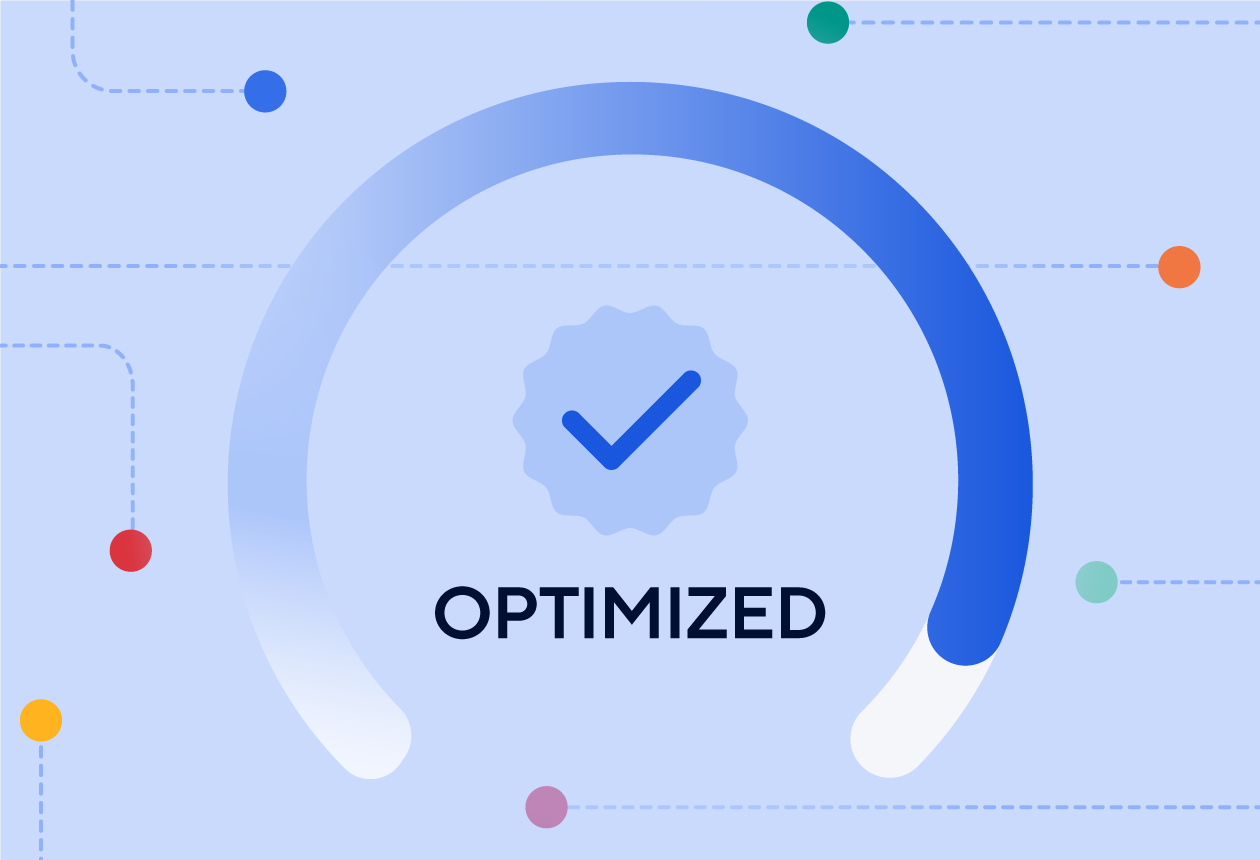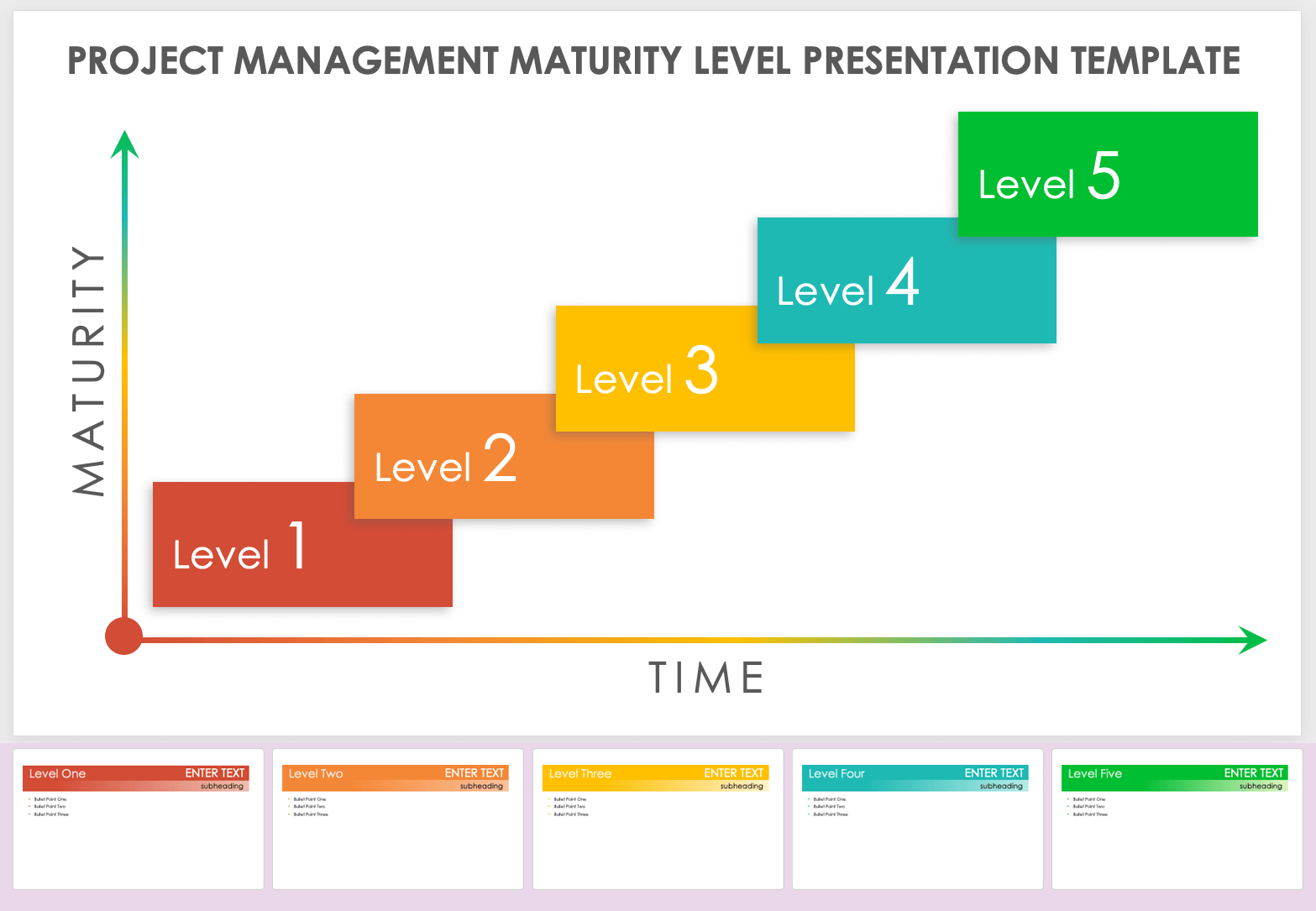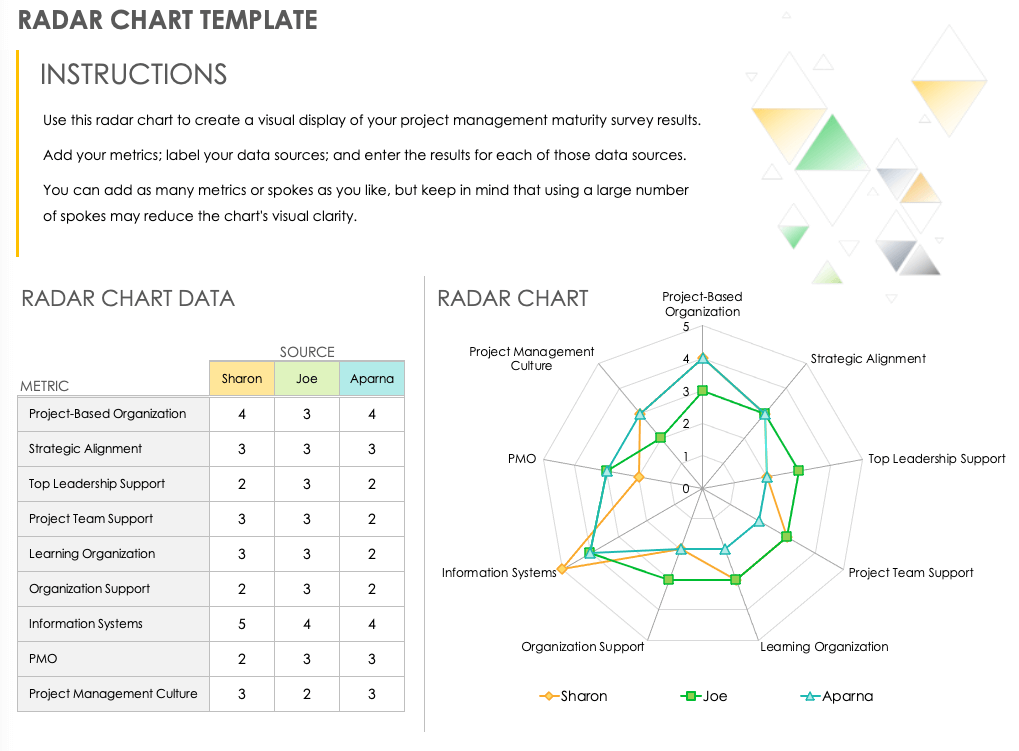What Is Project Management Maturity?
Project management maturity reflects a company’s ability to spearhead successful projects. If a company has high management maturity, its projects are more likely to meet objectives. Companies with underdeveloped maturity may not finish projects on time or within budget.
Having high project management maturity means planning, executing, and completing projects well. These teams follow defined, repeatable project management processes to minimize project risks and achieve strategic goals without relying solely on the talents and leadership of a few gifted individuals.
Gauging project management maturity is especially important for project-based organizations that use projects to perform work. Such organizations include engineering companies, film and video companies, law firms, and marketing and advertising companies. For these companies, leaders may place emphasis on building specialized skills without nurturing project management capabilities. By failing to foster robust project management processes, however, any organization risks financial loss.
Another important reason to nurture project management capabilities is that organizations often use a company’s project management maturity level to decide on partnering with them. In fact, the first Capability Maturity Model (CMM) was adopted by the U.S. government to evaluate potential contractors. Ultimately, project management maturity levels and models provide benchmarks that help both top management and potential business partners understand the returns on investment in project management.
Project management maturity develops when a company assesses its project management capabilities and commits to a course of improvement. Here are some characteristics of project management maturity:
- Projects finish on schedule.
- Teams mitigate risks and complete projects well.
- Finished projects reflect original goals.
- Projects deliver benefits.
- Projects continue successfully despite project changes.
- Project management applies good project governance throughout the organization.
Learn more about project management offices (PMO) and project management best practices in our comprehensive guide.
When a company assesses its project management capabilities against these criteria, it can identify methods for improving processes. Assessing project management maturity also helps organizations better understand their relative position in the competitive landscape.
Assess your PPM maturity
How can you help your team meet its goals faster?
As your projects scale in number and complexity, so should your readiness to tackle them. The Smartsheet PPM Maturity Assessment will help you understand your current state of people, process, and technology maturity and identify the best improvement scenarios that can validate your PPM investments.

Take this free, 10-minute Project and Portfolio Management (PPM) maturity assessment to pinpoint critical strengths, weaknesses, and opportunities to grow.
Project Management Maturity Model
Project management maturity models measure how well a company handles projects. These models provide criteria and scoring systems to assess capabilities. Models also provide a framework for implementing process improvements in the future.
Many project management maturity models are available, and project managers can determine which is the best fit for their organization by understanding the similarities and differences between their approaches. Many models stem from government agencies or large corporations, while others support specific industries, such as software development. Although as many as 29 models exist, the following seven models are some of the most common and can address the needs of most business types:
- Capability Maturity Model (CMM): Designed with contracted software projects in mind, the Capability Maturity Model determines a company’s maturity level by evaluating its standardized processes. This method includes two approaches to assessment and improvement: staged, which tracks a specific set of processes throughout an organization, and continuous, which follows process capabilities based on an organization's priorities. Once the evaluation is complete, managers rank the company based on the model’s five maturity levels: initial, managed, defined, quantitatively managed, and optimizing.
While the Capability Maturity Model is an excellent option for evaluating software companies, it is adaptable for any industry. The CMMI Institute, which owns the model, notes that companies in aerospace, finance, healthcare, information technology, software, defense, transportation, and telecommunications have found success using its methods. - Organizational Project Management Maturity Model (OPM3): The Project Management Institute’s (PMI) Organizational Project Management Maturity Model can help managers assess maturity levels in projects, programs, and portfolios. This model uses the same 10 knowledge areas of the Project Management Body of Knowledge (PMBOK®) guide to drive assessments, which are project integration, time, scope, cost, quality, human resources, risk, communications, stakeholders, and procurement. Once the assessment is complete, the model assigns one of four maturity stages: standardize, measure, control, and continuously improve.
This model is detailed and can be labor intensive, but any organization in any industry can use it to make a thorough assessment of, and ultimately improve, its project management processes. To learn more about project time management and the PMBOK® knowledge areas, see our comprehensive guide. - Project Management Maturity Model (PMMMSM): PM Solutions’ Project Management Maturity Model is another model that uses the PMBOK® 10 knowledge areas to create a standardized method for maturity assessment. When using this model, project managers assign one of five maturity levels to each knowledge area. These levels are the following: initial process, structured process and standards, organization standards and institutionalized process, managed process, and optimizing process.
- Berkeley Project Management Process Maturity Model: Applicable to any industry, the Berkeley project management process maturity model takes an incremental approach to improving a company’s maturity level. When using this model, project managers assess the maturity level of key project management processes and organizational characteristics and rank them on a five-stage maturity scale, which includes the ad-hoc, defined, managed, integrated, and sustained stages.
- Gartner Score Diagnostic Family: Founded in 2014, the Gartner Score Diagnostic Family is a collection of online maturity assessments. Highly customizable and adaptive, this model helps managers identify priority growth areas based on their company’s strategic aims. With its interactive, intuitive tools, the Gartner Score Diagnostic Family reveals which processes are undeveloped and provides a cross-functional overview of the areas that are critical to strategic planning.
- Kerzner’s Project Management Maturity Model: Kerzner’s project management maturity model is another incremental method for improving a company’s maturity. The Kerzner model defines each of its five maturity levels by the primary focus of that stage: common language, common process, singular methodology, benchmarking, and continuous improvement. For example, at the common process level, managers should work on designing and implementing standardized, repeatable processes, while at the continuous improvement level, managers should focus on monitoring current processes and tweaking them as needed.
- Portfolio, Programme, and Project Management Maturity Model (P3M3®): Designed by Axelos, the Portfolio, Programme, and Project Management Maturity Model (P3M3®) takes a wide-angle view of the entirety of a company’s interdependent processes to make an accurate maturity assessment. This model ranks maturity on a five-stage scale and gauges maturity based on seven core processes: organizational governance, management control, benefits management, risk management, financial management, resource management, and stakeholder management. In addition to improving organizational processes, this model is also useful for assessing and improving project portfolio management (PPM). To find more tools and expert tips on project portfolio management, see our all-inclusive guide.
Below is a diagram that compares three popular project management maturity models:
What Is the Purpose of a Project Management Maturity Model?
A project management maturity model helps a company assess and improve its ability to reliably complete projects on time and under budget. Organizations often make the costly mistake of undervaluing good project management practices.
A 2018 survey revealed that companies waste $1 million every 20 seconds because of poor project management. To avoid waste, you may consider conducting a maturity assessment if any of following are true for your company:
- Projects don’t have kick-off or close meetings.
- Projects lack charters and statements of work (SOW).
- Projects are not realistic or time-bound.
- Teams repeatedly fail to implement processes or tools.
- Managers don't get the results they need.
- Employees don't know what to do.
- Management doesn’t receive clear deadlines.
Assessing project management maturity and making necessary process improvements is a smart investment. Below are some of the tangible benefits of high project management maturity levels:
- Schedule and budget predictability
- Faster cycle times
- Increased productivity
- Fewer defects
- Decreased waste
- Greater customer satisfaction
- Higher employee morale
- Increased return on investment (ROI)
Which Project Management Maturity Model Should You Use?
There is no one-size-fits-all model for any industry or sector. The project management maturity model you choose will depend on many factors, including your company culture and your project management maturity goals.
Whichever model you choose, it will be a long-term commitment. Review all available options and consider what makes the most sense for your company’s specific needs.
All models begin with a formal assessment, whether through group and individual interviews or a questionnaire. Consider the types of questions included in the assessment. If your company is conducting a self-assessment, be sure that the survey contains pertinent questions for your industry and the problems you want to solve. P3M3®, for example, would be a useful model for companies looking to strategize across multiple projects and programs. The Gartner Score Diagnostic Family might be useful for companies that need guidance identifying areas of improvement.
Another consideration is the time and resources that will go into the assessment phase of a particular model. For example, OPM3 assessments require considerable effort, which may pose problems for smaller organizations.
But even more important than the type of model is how a team applies the model. “Your assessment is only going to be as good as your leadership will allow,” says Michele Barry, Principal Consultant at Frontis.
“It all comes down to the same fundamentals: great leaders empower their teams to use tools the way they should use the tools. I've seen so many times where leadership likes to dabble in what is proven to be a robust model. They cherry-pick what they'd like to have. That means that the model is not always implemented to its full opportunities. When I look at why something didn’t work, it's often because of the lack of discipline to see it through.”
Another important consideration is how intuitive a model is. Randall Englund, Project Management Institute seminar leader and author of seven business management books, stresses the importance of a simple, well-designed model. “They talk about 600-plus best practices. How do you internalize that and apply it?” he asks. “A lot of times, maturity models can be very academic. Academics love models. But as a practitioner, I look at those models and say, ‘How do I apply that?’ It should be intuitive. I don't think it takes a really elaborate model for maturity to improve. I think it takes people who are motivated to do it.”
Englund also developed his own assessment, the Environmental Assessment Survey Instrument (EASI), which measures how well your company supports project management. It contains 100 questions, which users answer on a scale of one to seven. Compare your scores with other organizations that have taken this survey, and plot a course for improvement with fellow employees.
Project Management Maturity Model Levels
Project management maturity models provide a framework for implementing improvements to a company’s processes by identifying and naming different maturity levels (stages). Once a company completes an assessment and identifies its level, it can begin working toward higher maturity levels.
In general, low-maturity project management means that projects are poorly planned and executed or not completed at all. High-maturity project management means teams or organizations have defined processes for performing project management that see projects planned and completed within budget and on time.
Just as there is no one perfect project management maturity model, no maturity level will capture all of the nuance and specificities of your company. Instead, these levels provide a useful framework for identifying the strengths and weaknesses of your current processes so you can begin to make improvements.
While the names and specifics of maturity levels differ between models, the following are general descriptions of five common maturity levels:
Level 1: Initial Process
Sometimes called the ad hoc or initial level, the initial process level represents the stage where a company has not yet implemented standardized project management processes. Project management is chaotic and there is little to no consistency between projects.
At this beginning level, project success is dependent on the initiative and capability of individuals. The organization lacks consistent teamwork.
Level 2: Repeatability or Standardization
At the repeatability or standardization level, an organization attempts to implement standardized, repeatable processes. Project managers track costs, timings, and functionality. Teams now plan projects and create reports to provide high-level overviews of project metrics and progress.
At this level, only big projects consistently adhere to standardized processes, while smaller projects fly under the radar. Some pundits consider an organization at this level to have achieved a basic level of maturity.
Level 3: Organizational Processes
At the organizational processes level, a company documents processes and integrates them into all parts of the organization. Employees are aware of processes and can reliably implement them. Most projects are completed on time and within budget.
At this level, organizations incorporate regular employee training and peer reviews.
Level 4: Measurement or Management
At the measurement or management level, companies implement clear metrics to track the success of processes and qualitatively control them. Team members and management have a good sense of project status and requirements.
This level indicates high maturity and can take three or more years of dedicated effort to achieve.
Level 5: Optimization
At the optimization level, organizations adjust their established processes. They pursue continuous improvement efforts and innovate. Some approaches to improvement include efforts to reduce and prevent defects and incorporate automation.
This level is the highest maturity level, which many organizations never reach. Those that do become an example to other organizations.
Project Management Maturity Model Levels Template
Download Project Management Maturity Model Levels Template
Microsoft Excel
|
Microsoft PowerPoint
| Google Slides
Use this PowerPoint or Excel template to explain maturity model levels and how they apply to your organization. Customize the levels or stages according to the model your company adopts. If necessary, include detailed information on each level to the subsequent slides.
How Is Project Management Maturity Measured?
Most models include a survey or questionnaire with which organizations can measure project management maturity. Often, consultants and project managers can augment the written survey with group or individual interviews. Companies also review documents and project results for completeness and quality.
Almost all practitioners acknowledge that measuring maturity is subjective and based on context. In general, measurement determines whether processes exist and how proficient teams are at following procedures to complete projects on time, within budget, and to the stakeholders’ satisfaction.
What Is a Project Management Maturity Assessment?
A project management maturity assessment helps a company understand the reliability and consistency of their current project management processes. Analyses include interviews, surveys, benchmarks, and document reviews, and they can be conducted internally with self-assessments or by a trained consultant.
Assessments should reveal the baseline current organizational experience and proficiency, highlight beneficial strategic capabilities, and indicate how an organization may achieve these improvements. A thorough evaluation includes the following elements:
- Artifact Collection: Reviewing documents helps managers determine whether or not teams follow processes and write project plans, and how well they do so. A document review also shows if practitioners understand why processes are important.
- Interviews: Conducting interviews individually or in groups helps reveal how widely teams apply processes and understand process importance. Personal interviews, in particular, can reveal commitment to and enthusiasm for following practices and process nuances.
- Questionnaires: Administering questionnaires is a more methodical, standardized method of determining project management maturity. Models offer either self-administered or 360-degree questionnaires. Companies often limit self-administered surveys to upper management and distribute 360-degree questionnaires to teams and individuals. The results of a 360-degree questionnaire administered by a third party may provide a more balanced perspective than self-administered surveys.
- Benchmarking: Benchmarking against other organizations provides an objective standard for considering a company’s efforts.
How Is a Project Management Maturity Assessment Conducted?
Companies can conduct project management maturity assessments using several tools and approaches. Assessment questionnaires, artifact reviews, general observations, and individual or group interviews all help develop an accurate sense of maturity.
Companies have the option to either conduct a self-assessment or bring in an outside consultant. Self-administered questionnaires may be completed as top-down exercises, where leadership assesses capabilities and initiates improvement efforts that the rest of the organization elaborates and executes. Consultants can be an individual or a team, and they can provide a fresh perspective and expert knowledge when reviewing artifacts, which are company policies, process, and procedure documents, and tangible evidence of project execution and results. Consultants also observe meetings and other company interactions.
If you choose to bring in a consultant, remember that employee engagement is key. A company can’t expect good results, Barry advises, if they hand everything to a consultant. “I think nothing in isolation,” she says. “As a consultant, I'd like to think that when I leave an organization, I've added capabilities within the organization to learn from other organizations. Regardless of what they're trying to implement, whether it's a project maturity model or a new change process or a new IT system, employee engagement needs to be part of it.”
When you choose a self-administered questionnaire, look for a survey with guidelines to help you interpret the results. Some models combine self-administered surveys with a consultant’s interpretive services. Questionnaires also vary in length. One adaptation, the PMI model, for example, has 36 questions, while the OPM3 assessment contains more than 800. A dedicated consultant administers the OPM3 questionnaire across the organization as a 360-degree assessment.
Raw numbers from questionnaires can’t convey the full complexity of how an organization behaves. As Barry explains, both teams and consultants must consider what’s going on behind answers and not take them at face value. “I know an organization that is on its third project of implementing a CRM. It should be simple. So many organizations do it. Every time this organization tries, it exposes the cultural challenges they have. And you know what they do? They find another consultant and try another system. Until I resolve the culture and the trust issues and get true sponsorship from the leadership, that's going to keep happening.”
Both individual and group perspectives are essential for conducting an accurate maturity assessment. Gartner suggests taking their assessment quiz individually and then gathering in-person or remotely to discuss and “norm” or align responses and future actions.
Radar Chart Template
Download Radar Chart Template
Microsoft Excel
| Google Sheets
Use this free radar templates to help visualize maturity model questionnaire results. Plot each assessment area’s score on its own axis. Overlay data from successive surveys to see how you’ve progressed. You can also use a radar chart to plot maturity levels for different departments, verticals, or functional areas.
How to Move Between PM Maturity Levels
Companies move between project management maturity levels when top leaders recognize project management value. Growth and change in a company depends on management's support for change.
In some models, such as P3M3®, each maturity level includes the necessary steps for advancement. This kind of built-in advancement structure can be a helpful guide, but management and teams need to commit to change if they want to see improvement.
Here are additional elements that enable a transition to higher maturity levels:
- Automation: Software can remove repetitive manual tasks and help teams become more forward-thinking and proactive.
- Champions: As with all initiatives, upgrading maturity needs the support of a committed executive team.
- Gradual Change: Managers should introduce new standards and processes incrementally as you initiate new projects.
- Resource Commitments: Stakeholders must commit time and money to prioritize process documentation and improvement.
- Tracking: Teams need purpose-built software and processes to track their uptake of the new processes and procedures.
- Training: Company leaders need to support new initiatives with training and documentation. Provide project managers and employees with access to industry best practices.
Advancement between specific levels may look like this:
- Advancing from Level One to Level Two: The organization recognizes a need for project management. Teams need training in the principles and methodologies of project management.
- Advancing from Level Two to Level Three: Teams understand the underlying principles of project management. The organization introduces processes and emphasizes cost and time controls.
- Advancing from Level Three to Level Four: Organizations integrate quality management and concurrent engineering practices. They refine processes and possibly introduce automation.
- Advancing from Level Four to Level Five: Companies track metrics and pursue internal and external benchmarks. They emphasize consistently choosing the correct objectives and projects to support strategic development.
- Maintaining Level Five: Companies pursue continuous improvement programs and choose projects with value propositions that situate the company for new opportunities.
What Is the Benefit of Knowing Your Project Management Maturity Level?
Knowing your project management maturity level provides a capability baseline from which you can begin to implement process improvements. As you achieve higher levels of project management maturity, your company will complete projects more reliably and develop a good reputation.
Understanding your company’s maturity level will help give you a realistic sense of your capabilities. Many companies think they are performing better than they actually are. By measuring levels once or twice a year, you can understand if you are growing or stagnating.
Increased maturity ultimately increases customer satisfaction. It improves the ability to close projects on time and within budget and increases return on investment in projects. Lower maturity levels can impede change.
What to Do with Your Project Management Maturity Level
Your project management maturity level provides you with a baseline for knowing where you stand and whether you’re improving. Levels also help you plan targeted and incremental improvements.
When company leaders understand their maturity level, they can set realistic and measurable goals for improvement. They will also be better positioned to identify and address process problems before a project fails.
Knowing the maturity level of potential partners or contractors can help you decide if you need outside resources to complete certain initiatives. As with other benchmarks, investors may use maturity levels as the basis for capital support.
However, knowing your maturity level and selecting a model do not guarantee change for your company. They are merely a gauge. Companies will see success when the leaders and team members understand the importance of project management and commit to process integrity.
History of Project Management Maturity
The first project management maturity models date back to the 1980s. The Software Engineering Institute (SEI) of Carnegie Mellon University originally developed the model so that the U.S. government could gauge how well external contractors could complete projects.
The SEI Capability Maturity Model (CMM) sought to bring consistency and repeatability to software development. Subsequent revisions extended CMM to other industries as the CMMI model, through the Capability Maturity Model Integration Institute.
In 1998, the Project Management Institute (PMI) realized that current models did not define maturity for complementary organizational or strategic efforts. They realized the need to accommodate the variability in individual companies. Teams working on this multiyear effort identified elements that contributed to maturity, which they identified as best practices. Other maturity elements the teams defined included capabilities, outcomes, and KPIs and metrics.
Many organizations and individuals have developed their own project management maturity models and made them available for external use. Other models have undergone adaptations and updates over the past three decades.
Power Your Project Management Maturity Model with Smartsheet
From simple task management and project planning to complex resource and portfolio management, Smartsheet helps you improve collaboration and increase work velocity -- empowering you to get more done.
The Smartsheet platform makes it easy to plan, capture, manage, and report on work from anywhere, helping your team be more effective and get more done. Report on key metrics and get real-time visibility into work as it happens with roll-up reports, dashboards, and automated workflows built to keep your team connected and informed.
When teams have clarity into the work getting done, there’s no telling how much more they can accomplish in the same amount of time. Try Smartsheet for free, today.



